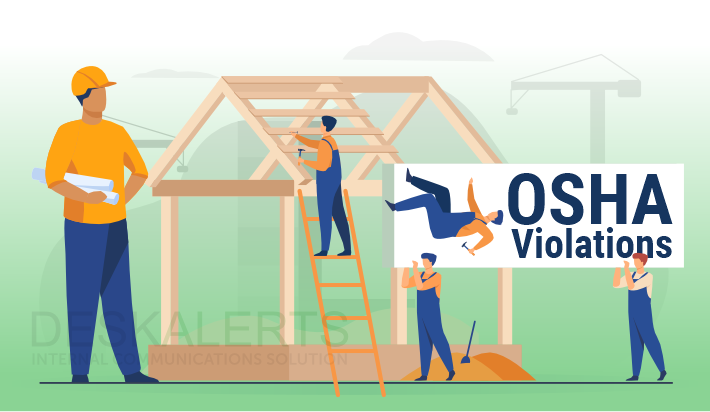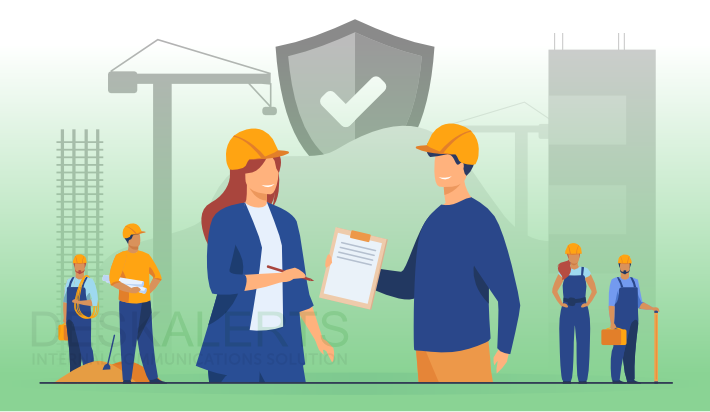
In today's fast-paced business landscape, where profitability often takes center stage, it's easy for workplace safety to slip down the list of priorities. However, ensuring a safe work environment isn't just a moral obligation - it's also a smart business move. Prioritizing safety not only protects employees from harm but also safeguards a company's reputation, bottom line, and long-term success.
Businesses must recognize the importance of meeting their obligations under the Occupational Safety and Health Administration (OSHA). These regulations set the standard for workplace safety and health, covering everything from hazardous materials handling to emergency preparedness.
By complying with OSHA requirements, companies can mitigate risks, avoid costly penalties, and foster a culture of safety.
But prioritizing safety in the workplace isn't just about ticking boxes - it's about creating a culture where safety is embedded in every aspect of the business. This means providing comprehensive training, conducting regular safety audits, and empowering employees to speak up about potential hazards. When safety becomes a top priority, everyone benefits - employees feel valued and protected, productivity increases, and the risk of accidents and injuries decreases.
Table of Contents
1. What is the OSHA?
2. Why do businesses need to comply with OSHA?
3. What happens if businesses fail to comply with OSHA?
4. What are OSHA violations?
5. Steps businesses can take to ensure OSHA compliance
What is the OSHA?
The Occupational Safety and Health Administration (OSHA) is a federal agency within the United States Department of Labor. Established by the Occupational Safety and Health Act of 1970, OSHA's primary mission is to ensure safe and healthy working conditions for employees across various industries.
OSHA is responsible for a number of regulations, enforcement, outreach, and training programs. The agency sets and enforces workplace safety and health standards, and conducts inspections to ensure compliance with these standards. It also provides guidance and assistance to employers and workers, offering resources such as training materials, OSHA safety topics, educational programs, and consultations to promote safety awareness and best practices.
Key responsibilities of OSHA include investigating workplace accidents, complaints, and reports of hazardous conditions, as well as issuing citations and penalties for violations of safety regulations. Additionally, OSHA works collaboratively with employers, labor organizations, and other stakeholders to develop and revise standards based on emerging risks and advancements in workplace safety technology.
Overall, OSHA plays a crucial role in safeguarding the well-being of American workers by promoting a culture of safety and enforcing regulations aimed at preventing workplace injuries, illnesses, and fatalities.
Why do businesses need to comply with OSHA?
There are several important reasons for businesses to comply with OSHA:
- Compliance with regulations on the OSHA violations list is essential for ensuring the safety and well-being of employees.
- By following OSHA standards, businesses can create a safer work environment, reduce the risk of workplace accidents and injuries, and protect their workers from potential harm.
- Adherence to OSHA regulations can help businesses avoid costly penalties, fines, and legal liabilities associated with non-compliance. OSHA has the authority to conduct inspections, issue citations, and impose significant fines on businesses that fail to meet safety standards. These penalties can not only result in financial losses but also damage a company's reputation and credibility.
- Compliance with OSHA standards also fosters employee morale and productivity. When workers feel safe and confident in their workplace environment, they are more likely to be motivated, engaged, and productive. Conversely, a lack of safety measures can lead to increased absenteeism, turnover, and decreased morale among employees.
- Avoiding non-compliance with the OSHA violations list demonstrates a commitment to corporate social responsibility and ethical business practices. Businesses that prioritize safety and health not only fulfill their legal obligations but also contribute to the well-being of society as a whole.
30 SAFETY MOMENT EXAMPLES TO USE IN YOUR WORKPLACE
What happens if businesses fail to comply with OSHA?
If a business fails to comply with OSHA regulations, it can face serious consequences that impact both its operations and reputation. Here are some potential repercussions:
- Fines and penalties: OSHA has the authority to issue citations and impose monetary penalties for violations of safety and health standards. These fines can range from hundreds to thousands of dollars per violation, depending on the severity and frequency of non-compliance.
- Legal action: In cases of egregious OSHA violations list non-compliance or repeated non-compliance, OSHA may pursue legal action against the business, including civil lawsuits or criminal charges. This can result in further financial penalties, legal fees, and potential criminal convictions for responsible parties.
- Potential jail time: If an employer is found guilty of a deliberate violation of a safety standard resulting in an employee's death, the penalty may include a fine imposed by the court, a maximum of six months' imprisonment, or both.
- Increased oversight: Businesses found to be in violation of OSHA regulations may be subject to increased regulatory scrutiny, including more frequent inspections and audits. This can disrupt normal operations and lead to additional costs associated with addressing compliance issues.
- Reputational damage: Non-compliance with OSHA regulations can tarnish a business's reputation and erode trust among employees, customers, and the public. Negative publicity surrounding workplace safety violations can have long-term consequences for the company's brand image and bottom line.
What are OSHA violations?
OSHA violations examples encompass breaches of workplace safety and health standards, ranging from inadequate fall protection and hazard communication to improper machine guarding and electrical safety violations.
List of most common OSHA violations
Across various industries, certain violations recur frequently, reflecting common challenges in workplace safety. Let's delve into the ten most common OSHA violations and citations faced by non-compliant businesses:
- Fall protection: Falls are one of the leading causes of workplace injuries and fatalities. Failure to provide adequate fall protection systems, such as guardrails, safety nets, or personal fall arrest systems tops the list of OSHA violations.
- Hazard communication: Businesses must ensure that employees are aware of hazardous chemicals present in the workplace and provide training on safe handling procedures. Violations typically involve inadequate labeling of chemical containers, lack of safety data sheets (SDS) or failure to conduct employee training.
- Scaffolding: Improperly erected or maintained scaffolding poses significant risks to workers. Violations in this category often include lack of proper scaffold construction, inadequate planking or decking, or failure to provide fall protection on scaffolds.
- Respiratory protection: Failure to implement a respiratory protection program or provide appropriate respirators can result in serious health consequences for employees exposed to harmful airborne contaminants. Common violations include inadequate respirator fit testing, improper respirator selection or lack of a written respiratory protection program.
- Ladder safety: Using ladders incorrectly or neglecting ladder safety precautions can lead to falls and injuries. Violations may involve using damaged or defective ladders, improper ladder placement or failure to provide ladder training to employees.
- Machine guarding: Machinery and equipment without proper guarding can pose severe hazards, such as entanglement, crushing, or amputation injuries. Violations often stem from missing or inadequate machine guards, lack of lockout/tagout procedures during maintenance or failure to conduct periodic inspections.
- Lockout/tagout (LOTO): Failure to implement lockout/tagout procedures when servicing or maintaining machinery can expose workers to hazardous energy sources, leading to serious injuries or fatalities. Violations include inadequate lockout/tagout procedures, failure to provide employee training or using improper lockout/tagout devices.
- Powered industrial trucks: Operating powered industrial trucks, such as forklifts, without proper training or safeguards can result in accidents and injuries. Common violations involve lack of forklift operator training, inadequate maintenance of equipment or failure to implement safe operating procedures.
- Electrical wiring methods: Inadequate electrical wiring methods can lead to electrical shock, electrocution, or fire hazards. Violations may include improper use of extension cords, inadequate grounding of electrical equipment or failure to protect wiring from damage.
- Heat protection: OSHA heat regulations mandate that employers must provide adequate training, access to water, and rest breaks to prevent heat-related illnesses among outdoor workers, ensuring compliance by implementing heat safety protocols and monitoring weather conditions regularly.
Understanding and addressing these common items on the OSHA violations list is critical for businesses to prioritize workplace safety and avoid costly penalties. By implementing comprehensive safety programs, providing adequate training on OSHA safety topics, and regularly assessing and addressing hazards, businesses can create a safer work environment for their employees while ensuring compliance with OSHA regulations.
30 SAFETY TOPICS AND MESSAGES
Steps businesses can take to ensure OSHA compliance
Here are several steps businesses can take to ensure they avoid OSHA violations list non-compliance and create a culture of safety:
- Familiarize yourself with OSHA violations list items relevant to your industry. OSHA provides comprehensive guidelines and standards covering various aspects of workplace safety and health. Understanding what is an OSHA violation example is crucial for identifying potential hazards and implementing appropriate controls.
- Regularly assess your workplace for potential hazards and compliance with OSHA standards. Conducting a thorough safety audit can help identify areas for improvement and prioritize corrective actions. Consider involving employees in the audit process to gain valuable insights into workplace safety issues.
- Establish a written safety program that outlines policies, procedures, and responsibilities for maintaining a safe work environment. Include protocols for hazard identification, accident reporting, emergency response, and employee training. Ensure that all employees are familiar with and adhere to the safety program. See how manufacturers use DeskAlerts for emergency and incident response.
- Train employees on OSHA safety topics including regulations, safe work practices, and the use of personal protective equipment (PPE). Offer comprehensive training programs tailored to specific job roles and hazards present in the workplace. Regularly review and update training materials to address changing safety requirements.
- Take proactive measures to eliminate or mitigate workplace hazards. Implement engineering controls, such as machine guards, ventilation systems, or ergonomic improvements, to minimize exposure to hazards. Additionally, establish administrative controls, such as work procedures and signage, to further reduce risks.
- Regularly inspect and maintain equipment, machinery, and facilities to ensure they are in safe working condition. Establish preventive maintenance schedules and promptly address any equipment malfunctions or safety concerns. Encourage employees to report maintenance issues promptly.
- Supply appropriate PPE, such as safety goggles, gloves, helmets, and respiratory protection, to employees exposed to workplace hazards. Ensure that PPE is properly fitted, maintained, and worn according to manufacturer instructions and OSHA requirements.
- Foster a culture of safety where employees feel comfortable reporting hazards, near misses, and safety concerns without fear of retaliation. Encourage open communication channels, such as safety committees, suggestion boxes, or anonymous reporting systems, to gather feedback and address safety issues proactively.
- Hold regular safety meetings or toolbox talks to discuss OSHA safety meeting topics, review recent incidents or near misses, and reinforce safe work practices. Use these meetings as opportunities to engage employees in safety initiatives, share best practices, and solicit input on safety improvements.
- Stay informed about changes in OSHA regulations, industry best practices, and emerging safety technologies. Continuously evaluate and update your safety program to address evolving workplace hazards and regulatory requirements to avoid non-compliance with the OSHA violations list. Adapt your safety practices based on lessons learned from incidents or near misses.
COMMUNICATION SOLUTION FOR MANUFACTURING
By following these steps and prioritizing workplace safety, businesses can demonstrate their commitment to protecting employees and ensuring compliance with OSHA regulations. Investing in safety not only reduces the risk of injuries and illnesses but also enhances employee morale, productivity, and overall business success.
***
Understanding OSHA regulations and implementing compliance measures is crucial for business success. It ensures a safe workplace, protects employees, and mitigates legal and financial risks. Prioritizing OSHA compliance not only fosters a positive work environment but also enhances productivity and long-term sustainability.
FAQ
What are some examples of OSHA violations?
Examples of OSHA violations in the workplace include failure to provide fall protection, inadequate hazard communication, improper machine guarding, lack of respiratory protection, and violations related to electrical safety, such as inadequate wiring methods.
Other common violations involve scaffolding safety, lockout/tagout procedures, forklift operation, and improper use of personal protective equipment. Failure to comply with OSHA regulations can result in citations, fines, and potential harm to employees.
What happens if a workplace is in violation of OSHA?
If a workplace is in violation of OSHA regulations, it can face serious consequences. OSHA may issue citations and fines for each violation, depending on the severity and extent of non-compliance.
These fines can range from hundreds to thousands of dollars per violation. Additionally, OSHA may require the employer to correct the violations within a specified timeframe and implement measures to prevent future occurrences.
In cases of egregious violations or repeated non-compliance, OSHA may pursue legal action, including penalties and potential criminal charges. Ultimately, failure to address OSHA violations can result in financial penalties, reputational damage, and legal liabilities for the employer.
What are three examples of OSHA at work?
Three examples of OSHA at work are:
- Conducting regular safety inspections to identify hazards and ensure compliance.
- Providing employees with comprehensive training on OSHA regulations and safe work practices.
- Implementing engineering controls, such as machine guards and ventilation systems, to minimize workplace hazards.
What are unacceptable working conditions?
Unacceptable working conditions encompass various factors that jeopardize the safety, health, and well-being of employees. Some examples include:
- Unsafe work environments with hazards such as exposed electrical wiring, slippery floors, or inadequate lighting.
- Lack of proper ventilation, leading to poor indoor air quality and potential exposure to harmful substances.
- Insufficient access to personal protective equipment or failure to provide appropriate training on its use.
- Overcrowded or poorly maintained workspaces, increasing the risk of accidents, injuries or ergonomic issues.
- Discrimination, harassment, or hostile behavior in the workplace, creating a toxic and stressful atmosphere.
- Inadequate break times or excessive work hours, leading to fatigue, burnout, and decreased productivity.
- Failure to provide fair wages, benefits, or adequate resources for employees to perform their job duties safely and effectively.
 Caroline Duncan
Caroline Duncan







